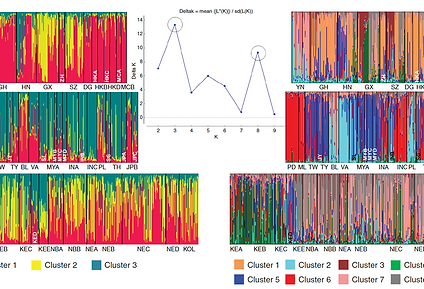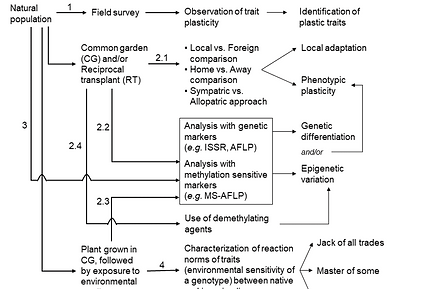Achyut
Postdoc work
Thesis abstract
Past, Present, and Future – Introduction history, current population structure, and potential distribution of an invasive plant species, Mikania micrantha, in South and Southeast Asia
Biological invasions are now considered a major global challenge for the conservation of natural resources and biodiversity. Mikania micrantha Kunth, a plant species of Latin American origin, has been considered one of the top invasive species of the tropical and subtropical belt of the world. The invasive ability and management implications of the species have been widely studied at regional and national scales. This thesis focuses on the species’ dispersal pathways outside its native range, genetic diversity, population structure, and potential distribution under current and future climate scenarios covering a large area of its invasive range in South and Southeast Asia.
Reconstruction of the introduction pathways of M. micrantha revealed evidence of at least six introductions in this region. The species is not at equilibrium with the current environmental conditions of its invasive range, thereby indicating ongoing range expansion of the species. Genotyping 1052 individuals from 46 populations at 12 nuclear microsatellite loci, persistent gene flow throughout the invasive range was found to provide beneficial genetic variation to the marginal populations, thereby facilitating range expansion of the species. High genetic diversity and strong population structure characterized the current genetic structure of M. micrantha in this region. Combining the genetic lineage information in an environmental niche modeling framework, a large area of South and Southeast Asia was found to be climatically suitable for both lineages, although significant differences between the climatic niches of the two invasive lineages were found. Finally, taking clues from the studies conducted so far, a unified framework of future experimental approaches was proposed to understand the molecular mechanisms of phenotypic variation of an invasive species and to disentangle the effects of standing genetic variation and epigenetic regulation of phenotypic variation.
The findings of this thesis can be used for continuous monitoring of the predicted suitable areas, devising site-specific management options, implementing quarantine measures to safeguard this region from novel introductions, and prioritizing areas for sampling classical biological control agents for M. micrantha.
Chapters
Climatic niche dynamics (published)
-
Most probable pathways of introduction into South and Southeast Asia were reconstructed based on literature reports, archival botanical records, and herbarium data.
-
Evidence in support of at least six introductions was found.
-
Species distribution modelling.
-
Although the climate conditions at the presumed introduction sites matched with the realised climate niche limit of the species in its native range, the species is not at equilibrium with the current environmental conditions of its invasive range.


Genetic diversity and population structure (published)
-
Analysis of genetic diversity and structure of 1052 individuals from 46 populations for 12 nuclear microsatellite loci,
-
High genetic diversity, the presence of multiple population clusters, and admixture between populations were found.
-
Persistent gene flow throughout the invasive range was found to cause low genetic differentiation among populations and provided beneficial genetic variation to the marginal populations in heterogeneous environments.
Genetically-informed SDM (published)
-
The genetic lineage information of M. micrantha in South and Southeast Asia was integrated into an environmental niche modelling framework.
-
A large area of South and Southeast Asia was found to be climatically suitable for both lineages, although significant differences between the climatic niches of the two invasive lineages were found.
-
Highlights the importance of integrating genetic data in future modelling studies to have finer-scale information on species’ distribution.


Genetic and epigenetic regulation of phenotypic variation (published)
-
Review work aimed at summarizing and synthesizing information on the genetic and epigenetic basis of phenotypic variation of alien invasive plants .
-
Taking clues from the studies conducted, a unified framework of future experimental approaches was proposed to understand the molecular mechanisms of phenotypic variation of an invasive species in its introduced range and to disentangle the effects of standing genetic variation and epigenetic regulation of phenotypic variation.
Mangrove phylogeography
Mangroves comprise tropical and subtropical intertidal plant communities and are valuable for providing a range of essential ecosystem services. Due to the foreseeable future of mangrove extinction through human exploitation, climate change, natural geographic events, and cryptic ecological degradation, it is important to understand their evolutionary history and present distribution. Unlike terrestrial plants, most mangroves have buoyant propagules capable of long-distance dispersal through ocean currents for an extended period of time, which plays a pivotal role in shaping the population structure of mangroves by maintaining gene flow between geographically distant populations. Multiple studies have identified multiple factors, including glacial vicariance and contemporary oceanic currents, which act as barriers to propagule dispersal and thereby can influence the geographic distribution of genetic variation within the mangrove species. However, the influence of these phylogeographic factors driving population structure is not consistent across mangrove taxa and geographic regions. Therefore, it is important to study the taxon-specific genetic structure of major mangrove lineages through regional sampling design across their distribution range for a better understanding of the phylogeographic factors shaping the geographic distribution of genetic variation.
My research interest is to assess the genetic diversity and population structure of the mangrove and mangrove-associated taxa across their distribution range and to identify the phylogeographic forces that would influence the present distribution of the species. I have studied the phylogeographic pattern of the following species using chloroplast DNA, nuclear DNA, and nuclear microsatellite markers.

All photos are sourced from Plants of the World Online (POWO).
The photos are linked to the publications on the respective species.






